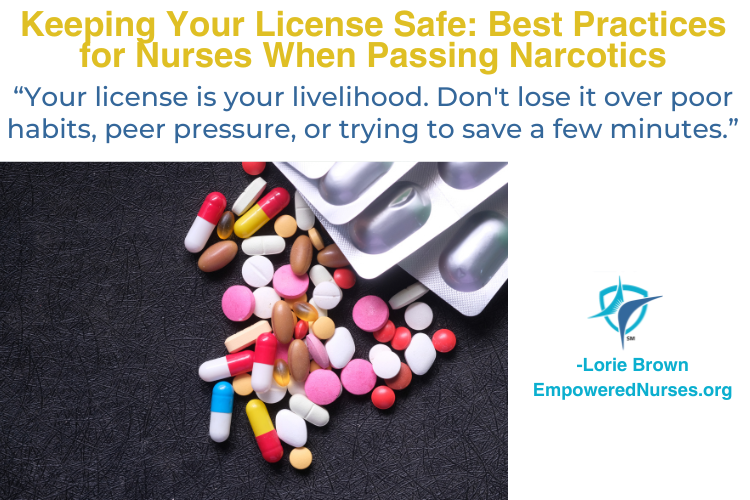Keeping Your License Safe: Best Practices for Nurses When Passing Narcotics

You’ve made it through nursing school, passed the NCLEX, and earned your license—now the real responsibility begins. One of the most high-stakes tasks you perform is administering narcotics. Whether in the ER, med-surg, ICU, or long-term care, passing controlled substances is routine—and it’s also one of the fastest ways to put your license (and livelihood) at risk if you’re not careful.
The Board of Nursing doesn’t take mistakes with narcotics lightly. Miscounts, poor
documentation, or even one careless shortcut can lead to accusations of diversion, patient harm, or negligence. So how do you protect yourself while providing excellent care?
Here are practical, no-nonsense strategies to help keep your license—and your patients—safe when handling narcotics.
1. Follow the “Five Rights”—Every Single Time
Yes, it’s basic. Yes, you’ve heard it a thousand times. And yes, it still matters.
· Right patient – Always use two identifiers.
· Right drug – Double-check—especially with similar-looking names.
· Right dose – Confirm unusual dosages with pharmacy or the provider.
· Right route – Don’t assume; verify.
· Right time – PRNs and scheduled meds should be tracked precisely.
These checks are your first defense against both patient harm and license jeopardy.
2. Know—and Follow—Your Facility’s Policy
Every facility has its own medication handling protocols. Review them. Understand them.
Follow them precisely.
If something goes wrong, “I didn’t know” is not a valid defense. Protect your license by making policy your daily guide.
3. Remove Narcotics from Pyxis Responsibly
Automated dispensing cabinets like Pyxis track everything. You’re being monitored, and the
clock starts ticking the second you pull the med.
· Administer the med within 30 minutes of removal—otherwise, you’re out of compliance in most institutions.
· Do not carry narcotics in your pocket while doing other tasks. If something goes
missing, it’s your name on the log.
· If you pull a med and the patient refuses or it’s not needed, waste it within 30 minutes, with a witness and document why it was all wasted.
· Be sure to scan the patient to document the administration of the medication.
Don’t let narcotics sit around or become an afterthought. Treat each one like it’s being watched—because it is.
4. Document Immediately—and Thoroughly
Never chart after the fact when it comes to narcotics.
· Record exact time, route, and dose.
· Document patient response—especially for IV or PRN meds.
· If a portion is wasted, record it immediately with a co-signature.
Avoid generic notes like “pt comfortable.” Be specific: “Pt reports 7/10 pain, received 2 mg IV morphine, pain reduced to 3/10 in 10 minutes.”
If you’re ever under review, clear and timely documentation is your best friend.
5. Don’t Be the Outlier
You may not think anyone’s watching how many narcotics you give—but someone is. Pharmacy, nursing management, and compliance teams regularly pull utilization reports.
If you’re consistently:
· Giving more PRNs than your peers,
· Wasting more than others,
· Pulling meds at odd hours or just before the end of shift,
…you will stand out—and not in a good way. Even if you’re doing nothing wrong, being an outlier puts a target on
your back.
Stay aware of your usage patterns and keep communication open. If a patient is truly needing
frequent pain management, document why—and make sure the care team is aligned.
6. Never Pre-Pour or Pass Off Narcotics
You should never:
· Pre-pour narcotics for later,
· Leave them at the bedside,
· Hand them off to another nurse or tech to administer.
These shortcuts are policy violations and potential diversion red flags. Always administer
narcotics personally and watch the patient take them.
7. Waste with a Witness—On the Spot
Wasting narcotics is not a “do it later” task.
· Waste it right after preparing the dose.
· Always have a licensed nurse witness—and sign off together.
· Never carry unadministered narcotics hoping to waste them later in the shift.
Delays in wasting raise suspicion and increase your liability.
8. Don’t Let Anyone Pressure You
You might encounter a doctor, supervisor, or coworker who tries to rush you, question your
judgment, or suggest bending a rule “just this once.”
Stay firm. You are accountable for every medication you pass. Your license is not worth
someone else’s shortcuts.
Final Thoughts: Keep It Tight, Keep It Safe
Handling narcotics is one of the most legally vulnerable aspects of bedside nursing. Every move you make—from removing meds from the Pyxis to documentation—must be done with precision, clarity, and integrity. Any discrepancy, the Board thinks you are using, selling or incompetent. It is a lose-lose situation.
Your license is your livelihood. Don’t lose it over poor habits, peer pressure, or trying to save a
few minutes. Treat every narcotic administration like it’s being audited—because one day, it might be.
What’s your best tip for safely passing narcotics? Drop it in the comments and help your fellow nurses stay safe, smart, and secure.


